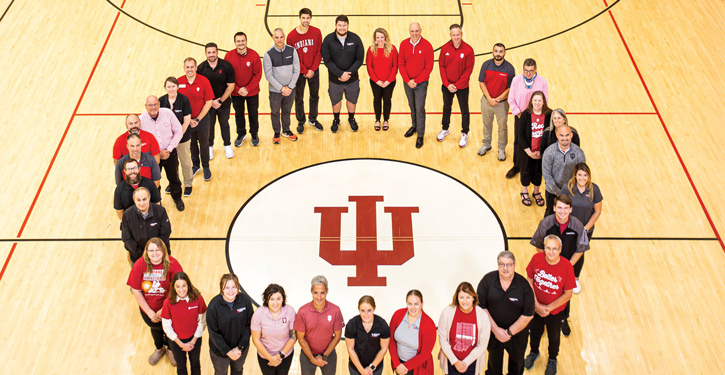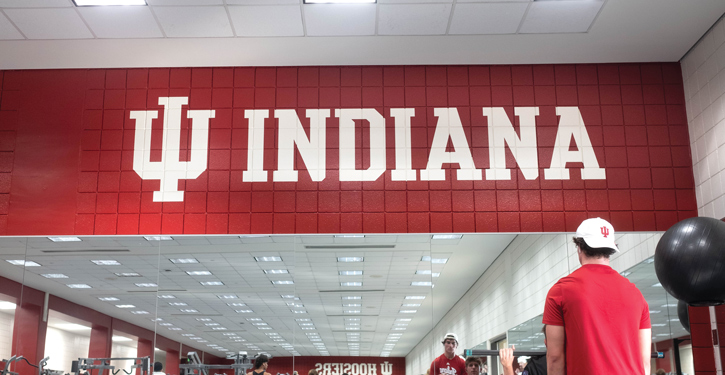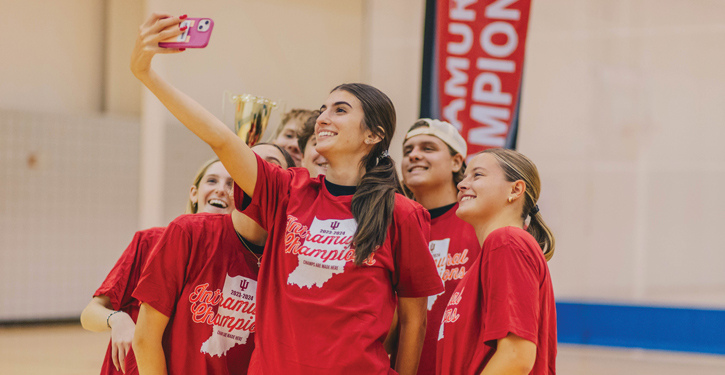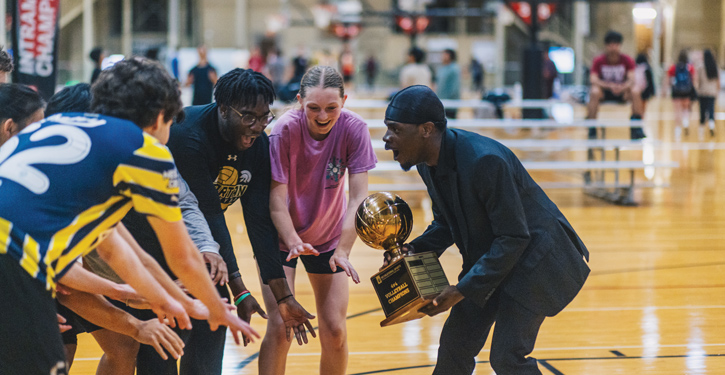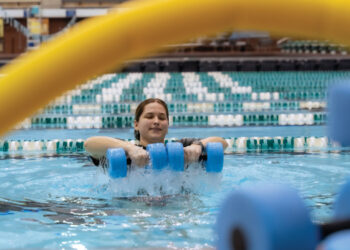When a new member of campus administration toured the Student Recreational Sports Center at Indiana University (IU), they made a comment Chris Arvin would never forget.
“They said, ‘This is a beautiful building. I’m sure you do a nice job of running the facility, but it doesn’t feel like I’m at IU. I could be on any campus in the country,’” recalled Arvin, the executive director of Recreational Sports.
The comment came due to a lack of IU colors and branding in the facility. Built in 1995, the center had veered away from looking too athletic through the years in order to be as welcoming as possible to all students. There was a noticeable lack of Hoosier pride in the facilities as the yellow, green and blue color scheme did not align with the cream and crimson school spirit. However, Arvin and the Recreational Sports team knew it was time for a change — or maybe two or three.
“One focus over the last year has been IU-ifying our facilities and maximizing square footage to meet student needs, improve our member experience, and enhance belonging through the built environment,” said Arvin.
EXTRA CREDIT: Episode 23 of the Director Download with Chris Arvin at Indiana University
As such, 2024 has seen the following renovations and improvements at Recreational Sports’ facilities:
- A complete overhaul of the main strength gym.
- Converting three racquetball courts into strength studios.
- Adding all-gender restrooms and showers.
- Top-to-bottom repainting with a cream and crimson theme.
- IU branding installations.
- Digital screens for programmatic and campus partner promotional opportunities.
- Addition of a dedicated wellness and recovery studio.
- High and duct cleaning.
- Reorganization of all storage areas.
- Rearranged staff offices to increase team efficiency.
- Opening a new outdoor court in one of IU’s three residential neighborhoods that includes a soccer turf, basketball court, six pickleball courts and an outdoor fitness court.
- A $50 million state-funded renovation of the School of Public Health and the Bill Garrett Fieldhouse focused on accessibility and mechanical improvements.
While it’s been a tall order the past year, the changes at IU have been part of a larger collective commitment toward student well-being and belonging. Each and every alteration amplifies this goal. Hannah Armstrong, the associate director of Operations, said they did a deep initial dive on the Student Recreational Sports Center. “We’ve gone through every single square foot to determine what we can do to reimagine and reprioritize space in ways that support our students’ needs,” she said. “It’s with a thoughtful lens of how do we make our square footage the best possible space to support what students need and desire.”
Adapting Fitness Spaces to Current Trends
Another example of that thoughtfulness is the complete overhaul of the largest strength gym space on campus. Arvin shared they’ve followed the overall fitness trend of moving from cardio to strength. In fact, they now offer 16 stations with rigs, barbells and plates. “It looks like a D1 athletics weight gym because that’s what folks are asking us for,” said Arvin. “The vast majority of our students will never have the opportunity to use those Athletic spaces, but we have a chance to help them feel that school pride through our recreation spaces to help build a sense of belonging.”
However, the Recreational Sports team also asked the question of what types of cardio are students doing? At IU, they found treadmills, step mills and bikes are the most popular, so that’s the majority of what you’ll find on the floor.
“We’re staying up with our students’ needs and wants,” said Armstrong. “That’s super important for every program we do, every space we have and every initiative we engage in, because this generation of students who lived through the pandemic at a time in their developmental lives really care about wellness in a different way.”
To understand who they’re serving better, the IU team has surveyed students to learn more about their recreation and wellness needs. The majority of students said Recreational Sports helps them connect to IU broadly, allows them to feel connected to others and influences their personal wellness — which Arvin said they didn’t define purposefully — in positive ways. “We can get caught up sometimes on the academic definition of what is wellness,” he elaborated. “But at the end of the day, the way a student or an individual defines wellness and uses our spaces to meet their needs matters.”
A Group Effort
Influencing that wellness impact has been boosted by the entire team’s collective commitment to participate in the NIRSA Recreation for Wellbeing course. Josh Downing, the associate director of Programs, was critical to the IU team completing the course as well as its overall development through his leadership with the NIRSA Health & Wellbeing Task Force.
The eight-week course consisted of learning the foundations of well-being, why it’s important, how to put it into practice and the steps to advocate for well-being on campus. Going through it has brought the team to a foundation of language and a change in how they think about well-being. “It’s shifting the mindset and getting the collective team around the concepts, the foundational knowledge and the shared understanding of how we can collaborate to help support this on our campus,” said Downing. “The team gets it and is prioritizing the next steps for how each unit can expand and grow to focus on well-being.”
EXTRA CREDIT: Mental Health First Aid Training Prepares Staff at Indiana University
For example, the team has taken a hard look at the policies surrounding student employees and whether there are any unnecessary barriers. They’ve also asked how they can further use their GroupMe — called Rec Connect — that allows students to connect based on interests. For example, if someone is looking to play pickleball, they can ask on the GroupMe app and find others who are also wanting to play the sport.
With IU’s 2030 strategic plan identifying student wellness as a priority, RecSports leadership felt the course was an important step to align with this priority. In addition, each team member has been challenged to come away with their own action proposals. “It’s so powerful that it went across the entire organization,” said Downing.
Collective Commitment
But of course, Recreational Sports can’t achieve belonging and well-being alone. They recognize it’s a campus-wide effort, hence the strategic plan.
One such example of IU’s collective commitment is the partnership with the Residence Hall Association (RHA). Arvin said they floated the idea by RHA a few years ago to help support swim lessons and subsidize a color run at the time. From there, it’s just grown. Students who live in residence halls now have access to a personal training starter package and free intramurals. Arvin noted that makes it especially easy for first year students to get engaged.
And now, Recreational Sports is partnering with Campus Auxiliaries to open a new outdoor space in one of their residential neighborhoods. Both departments brought money to the table and agreed to a collaborative use of the 30,000-square-foot plot with a soccer turf, a basketball court and six pickleball courts, in addition to connecting with the National Fitness Campaign for an outdoor fitness pad.
Achieving the Goal
Again, it all comes back to the collective commitment of Recreational Sports and its laser-focus on the student experience. Ultimately, the goal is to lead to student success, and in 2024 it was found those who visited Recreational Sports 32-plus times a semester averaged a 3.44 GPA while non-participants averaged a 3.28 GPA. The highest? Recreational Sports’ employees who averaged a 3.54 GPA.
Based on the above data, it seems the team is achieving its goal on IU’s campus. Plus, with a year of renovations behind them, the Recreational Sports team is set up even better to continue their collective commitment to the students who have been there through all the changes.
“Recreational Sports has always worked to create a culture of well-being that allows students to manage stress, achieve academic success and maximize personal wellness while having a bit of fun at the same time,” said Downing. “We’re uniquely positioned as an entry point on campus for students to focus on their health and well-being, and to be a prominent entry point to support their health and well-being.”


